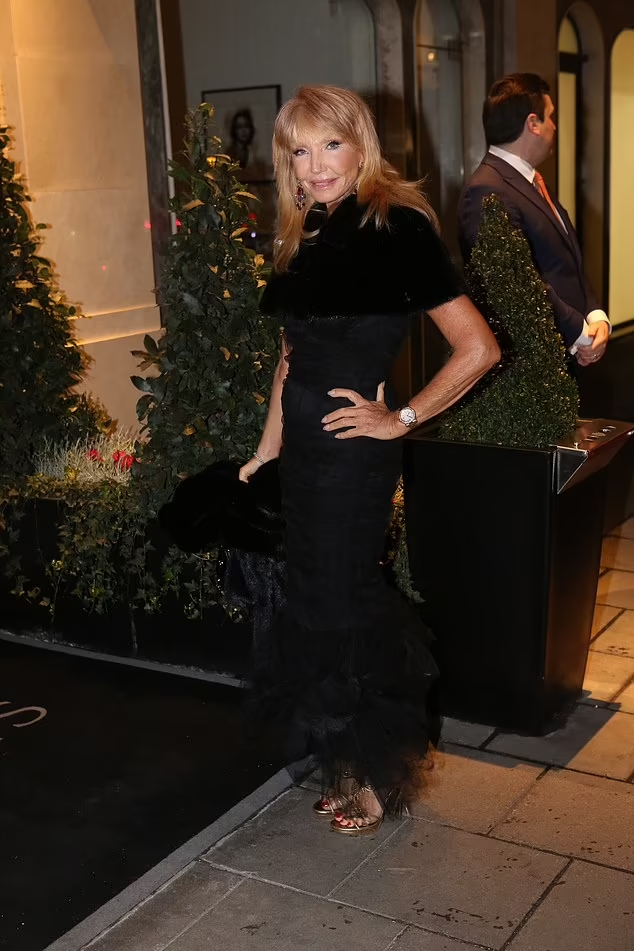
The former Bond Girl, 72, who rose to fame alongside Roger Moore in 1977’s The Spy Who Loved Me, refused traditional treatment options to battle the grade 3, stage 2 disease back in 2007 (pictured in the film)
The former Bond Girl, 72, who rose to fame alongside Roger Moore in 1977’s The Spy Who Loved Me, refused traditional treatment options to battle the grade 3, stage 2 disease back in 2007.
Susie told of how she beat the aggressive breast cancer, which had spread to her lymph nodes, with alternative therapies, after having surgery to removed the tumour.
Speaking to The Express, she revealed: ‘They wanted me to have the chemo, the drugs, the radiation, the Herceptin.
‘But I started reading all these books and I thought that the chemotherapy would be a disaster because it kills everything in your body.’
The actress explained how she ‘found a guy in Dusseldorf’ who sent her tumour for tests to find out how it could be killed with ‘natural ingredients.’
‘He changed my diet completely. No sugar, no alcohol, no meat, lots of vegetables, and intravenous vitamin C, with the occasional steamed wild fish,’ she said.
Susie added in an interview with Best Magazine: ‘I just thank God that I’m still alive and I lived to tell the tale.
My older brother did pass from cancer, though – but unlike me he took all the chemotherapy, which I personally think really destroyed his immune system.
‘I didn’t take any drugs at all. So, you just never know. I had grade 3, stage 2 in my lymph nodes, I took a lot of vitamin C and we watched as the cancer cells went down.’
There are over 100 types of chemotherapy drugs, but they all work in a similar way and circulate through the blood.
The drugs are cytotoxic, meaning they are toxic to cells and in particular those that divide rapidly.
As cancer cells divide more than healthy cells, they are more affected by chemo, hence why it is used as a treatment for the disease.

Susie Vanner has revealed how she ‘beat the odds’ after rejecting chemotherapy when she was diagnosed with breast cancer (pictured in 2022)
However, other types of fast-growing cells, such as hair, bone marrow, skin and the lining of the digestive system are also damaged in the process.
One in seven women in the UK are diagnosed with breast cancer in their lifetime — around 56,000 a year — making it the most common cancer in the UK.
The figure stands at roughly 300,000 annually in the US.
Between 85 to 90 per cent of women diagnosed with primary breast cancer survive more than five years.
However, other types of fast-growing cells, such as hair, bone marrow, skin and the lining of the digestive system are also damaged in the process.
One in seven women in the UK are diagnosed with breast cancer in their lifetime — around 56,000 a year — making it the most common cancer in the UK.
The figure stands at roughly 300,000 annually in the US.
Between 85 to 90 per cent of women diagnosed with primary breast cancer survive more than five years.
Breast Cancer Is One of the Most Common Cancers in the World and Affects More Than Two MILLION Women a Year
Breast cancer is one of the most common cancers in the world. Each year in the UK there are more than 55,000 new cases, and the disease claims the lives of 11,500 women. In the US, it strikes 266,000 each year and kills 40,000. But what causes it and how can it be treated?
What is Breast Cancer?
It comes from a cancerous cell which develops in the lining of a duct or lobule in one of the breasts.
When the breast cancer has spread into surrounding tissue it is called ‘invasive’. Some people are diagnosed with ‘carcinoma in situ’, where no cancer cells have grown beyond the duct or lobule.
Most cases develop in those over the age of 50 but younger women are sometimes affected. Breast cancer can develop in men, though this is rare.
Staging indicates how big the cancer is and whether it has spread. Stage 1 is the earliest stage and stage 4 means the cancer has spread to another part of the body.
The cancerous cells are graded from low, which means a slow growth, to high, which is fast-growing. High-grade cancers are more likely to come back after they have first been treated.
What Causes Breast Cancer?
A cancerous tumour starts from one abnormal cell. The exact reason why a cell becomes cancerous is unclear. It is thought that something damages or alters certain genes in the cell. This makes the cell abnormal and multiply ‘out of control’.
Although breast cancer can develop for no apparent reason, there are some risk factors that can increase the chance, such as genetics.
What are the Symptoms of Breast Cancer?
The usual first symptom is a painless lump in the breast, although most are not cancerous and are fluid filled cysts, which are benign.
The first place that breast cancer usually spreads to is the lymph nodes in the armpit. If this occurs you will develop a swelling or lump in an armpit.
How is Breast Cancer Diagnosed?
* Initial assessment: A doctor examines the breasts and armpits. They may do tests such as a mammography, a special x-ray of the breast tissue which can indicate the possibility of tumours.
* Biopsy: A biopsy is when a small sample of tissue is removed from a part of the body. The sample is then examined under a microscope to look for abnormal cells. The sample can confirm or rule out cancer.
If you are confirmed to have breast cancer, further tests may be needed to assess if it has spread. For example, blood tests, an ultrasound scan of the liver or a chest X-ray.

By testing tumors, researchers hoped to identify women who could avoid chemotherapy without increasing their risk of a cancer recurrence. ~ Voisin/Phanie/Science Source
How is Breast Cancer Treated?
Treatment options which may be considered include surgery, chemotherapy, radiotherapy and hormone treatment. Often a combination of two or more of these treatments are used.
* Surgery: Breast-conserving surgery or the removal of the affected breast depending on the size of the tumour.
* Radiotherapy: A treatment which uses high energy beams of radiation focused on cancerous tissue. This kills cancer cells, or stops them from multiplying. It is mainly used in addition to surgery.
* Chemotherapy: A treatment of cancer by using anti-cancer drugs which kill cancer cells, or stop them from multiplying.
* Hormone treatments: Some types of breast cancer are affected by the ‘female’ hormone oestrogen, which can stimulate the cancer cells to divide and multiply. Treatments which reduce the level of these hormones, or prevent them from working, are commonly used in people with breast cancer.
How Successful is Treatment?
The outlook is best in those who are diagnosed when the cancer is still small, and has not spread. Surgical removal of a tumour in an early stage may then give a good chance of cure.
The routine mammography offered to women between the ages of 50 and 71 means more breast cancers are being diagnosed and treated at an early stage.
For more information visit http://breastcancernow.org/
Written by Laura Parkin for The Daily Mail ~ November 7, 2024
